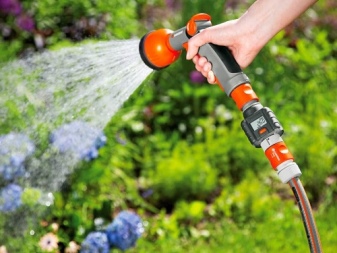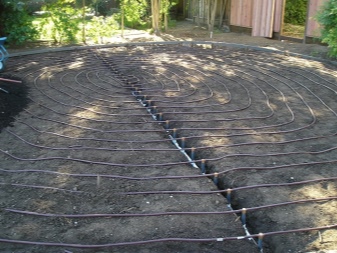How do I water my lawn after planting?

Every lawn owner wants to keep their lawn healthy. However, this requires a lot of activities, the most important of which is watering. The irrigation of the green carpet must be correct, otherwise it will damage the vegetation.

Irrigation types
Any representative of the flora needs irrigation after planting, since without water, vital processes in the tissues will not occur at the proper level. Watering the lawn after planting is necessary, otherwise you can expect:
- the appearance of dried spots on a green carpet;
- color change of stems;
- folding the stems;
- untidiness of the appearance of the lawn;
- after pressing, the grass will not straighten.
There are two types of lawn watering.
- Manual. If the lawn, rolled or sown, is located in a small area, or it is not possible to install an automatic irrigation system, then manual irrigation will be the way out of the situation. In this case, watering the green lawn is carried out using a spray nozzle. The latter is connected to a garden hose through which water flows from the source. This option is much faster and more convenient than irrigating vegetation with watering cans and buckets.
- Automatic watering simply irreplaceable if the territory of the lawn is more than 6 acres. The automatics are installed even before laying or sowing lawn grass, so all its elements are reliably hidden.
These irrigation systems are usually equipped with several types of sprinklers.


Water quality and temperature
When watering your lawn, you should pay attention to the quality of the water. If a chlorinated liquid flows in the water supply, then it will be dangerous to use it for irrigation. Large amounts of chlorine can kill plants. Therefore, it will be correct to water the lawn with settled water, and you can also install filters on the irrigation system.
The liquid that is watered with a rolled lawn must have a temperature of at least 10 degrees above zero. In an automatic irrigation system, water heats up to the desired temperature while it flows through the pipes. If the area is irrigated by hand, it is better for the liquid to stand for a while. Cold water combined with heated soil can cause temperature shock at the roots of plants.

Periodicity
Watering the park lawn very often after the grass has been laid can cause stagnant water, which usually leads to the development of fungal diseases. This rule applies to heavy and dense soil. In such an area, it is recommended to equip a drainage system before the lawn is planted. The best option for the frequency of watering the lawn after sowing seeds is considered fragmentation, as well as the use of small portions of water. On loose soil, abundant irrigation causes moisture seepage and nutrient leaching.
The number of waterings depends on a number of points.
- Territory landscape. The lawns that are located on the slope require more frequent watering than those located in the lowlands.
- Soil and its ability to hold water.
- Weather.
- A type of growing grass that can be either moisture-loving or drought-tolerant.
- Season.
During a drought, it is worth watering the lawn daily. If it is cloudy outside and the ambient temperature does not drop below 15 degrees Celsius, then water it every 3-7 days. Outside the schedule, irrigation is carried out at the end of mowing and fertilization.

Auspicious time
Watering your lawn more often in summer and spring than during the cooler season. The ideal time of day for irrigation is morning. Watering your lawn in the middle of the day can result in burns to vegetation and unnecessary waste of large amounts of liquid. Evening watering for the lawn is undesirable. The reason is that the greens will remain wet overnight, and this can cause the development of some ailments. After lunch, water the lawn between 4 pm and 6 pm.
Late evening irrigation is possible only in a very hot summer, when the air temperature is more than +40 degrees during the day and at least +28 degrees Celsius at night. The liquid in the soaked soil will keep the vegetation from burning.

Equipment
Many have already refused to water their lawns with a hose. Such an event not only increases fluid consumption, but also makes irrigation uneven. In addition, a heavy jet of water damages or completely washes away the top layer of the soil, breaking the stems and roots of plants.
There are several of the most convenient modern lawn watering methods.
- Drip. This convenient and economical irrigation option is often used by summer residents. The automatic system includes hoses, pipes with valves, filters for cleaning and a control unit.
- Sprinkling Is a set of equipment that evenly moisturizes the entire area of the green lawn. The sprinkler is characterized by imitation of natural precipitation. Thanks to such an irrigation system, not only the grass and soil are watered, but also the foliage is cleared of dirt and dust. Automatic sprinkler irrigation is connected to a water supply system or a container filled with liquid and equipped with pipes, nozzles. Sprinkling can be both mobile and stationary.
- Subsoil. Subsoil irrigation is the most expensive and at the same time efficient. The elements of the system are mounted at a depth of 20-30 cm. This irrigation method is considered the best option for lawns that are located on slopes.


Several types of sprinklers can be found on the market today.
- Oscillating. The equipment looks like a short tube with holes. It is ideal for large area irrigation systems.
- Rotary. This type of sprinkler sprays water using a rotating head. With this equipment, you can always adjust the radius of rotation. Rotary sprinklers are universal, so they can be used in areas of different sizes.
- Fan-shaped. As in the previous version, this sprinkler is adjustable long-range action. Such equipment is convenient for use on a flat horizontal lawn.
- The pulsating throws out liquid in a jet. Typically these sprinklers are used in combination with other units. This type of equipment is suitable for compact lawns. A feature of the pulsating sprinkler is the ability to set the angle of irrigation, which contributes to the irrigation of the corner zones of the lawn.
- Micro-sprinkler. The use of this type of equipment is considered the most gentle. Water is supplied through a nozzle in the form of a multitude of streams that do not damage even the weakest grass. Installing micro-sprinklers is considered the best option for a lawn with flower beds.
In order for the automatic irrigation installed on the site to serve for many years, the owner will need to perform some care measures:
- inspect and clean the nozzles;
- charge the battery on time;
- preserve equipment for the winter;
- monitor the status of filters.
Proper watering is a guarantee of a fresh and beautiful green lawn. In case of improper organization of irrigation or its complete absence, the green lawn may die. In order to save water and your own time, it is better to install an automatic irrigation system.


For information on how to properly care for your lawn, see the next video.



































































The comment was sent successfully.